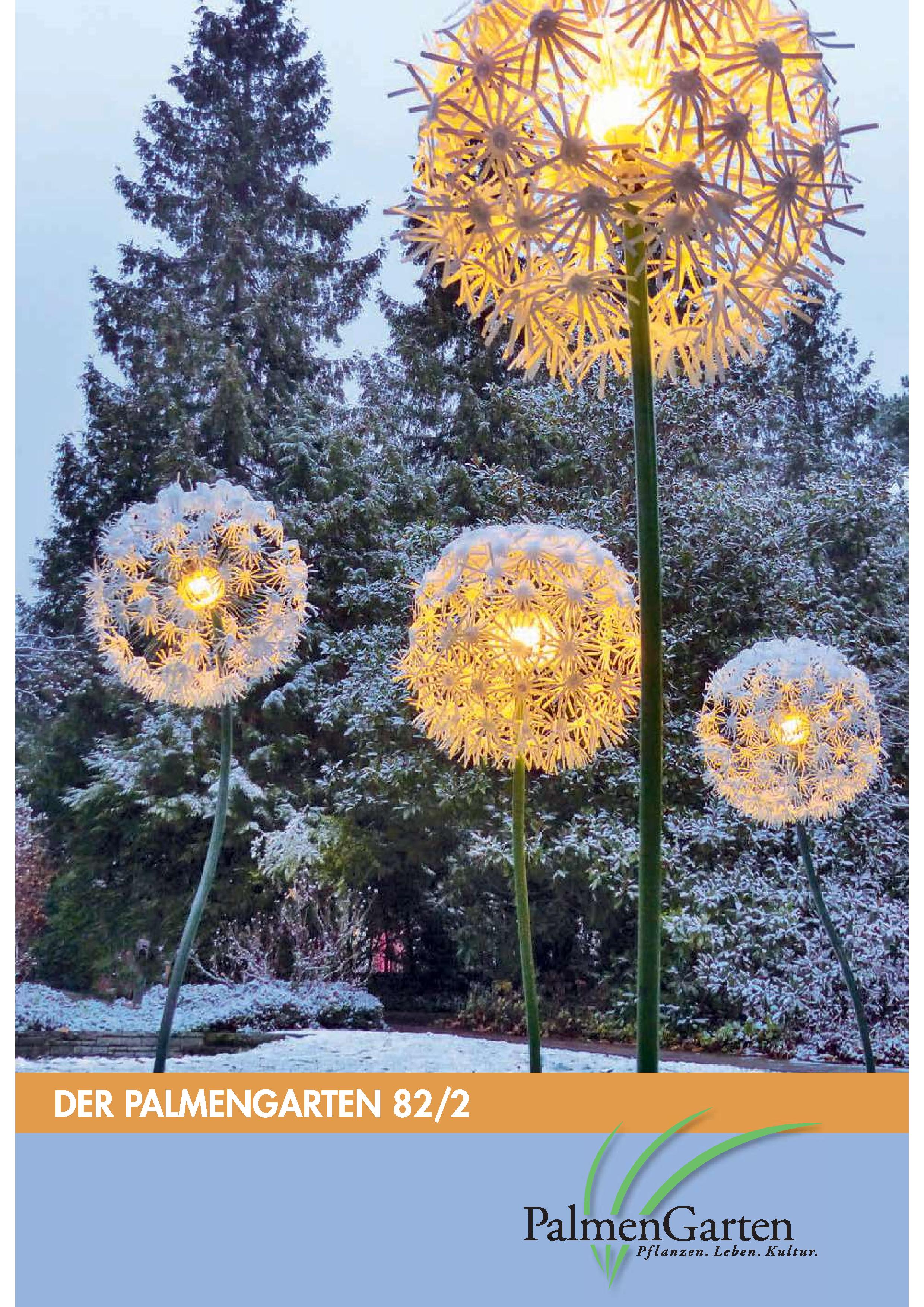Die großen wissenschaftlichen Leistungen von Stefan Vogel (1925–2015) Teil 5b. Öl statt Nektar – die Ölblumen (dikotyle Vertreter)
DOI:
https://doi.org/10.21248/palmengarten.482Abstract
Ölblumen haben sich im Laufe der Evolution in 11 Pflanzenfamilien entwickelt und selbst innerhalb dieser Familien sind sie oft mehrfach und voneinander unabhängig entstanden. Im vorliegenden Artikel werden, aufbauend auf den morphologischen Analysen und Bestäubungsbeobachtungen von Stefan Vogel, wichtige Vertreter der Dikotyledonen vorgestellt. Die Familien sind meist tropisch- und subtropischer Provenienz. Eine Ausnahme bilden die Primulaceae, in der etwa 40 % der Arten der Gattung Lysimachia fettes Öl als florales Attraktans anbieten. Lysimachia bzw. ihre ölblütigen Vertreter haben eine holarktische Verbreitung und sind mit einigen wenigen Arten auch in Mitteleuropa vertreten. Die Bestäubung erfolgt durch hochspezialisierte Bienen, den sogenannten Schenkelbienen (Macropis, Melittidae).
Literaturhinweise
Aguiar, A. J. C. & Melo, G. A. R. 2009: Notes on oil sources for the bee genus Caenonomada (Hymenoptera, Apidae, Tapinotaspidini). – Rev. Brasil. Entomol. 53: 154–156. https://doi.org/10.1590/s0085-56262009000100033
Anderberg, A. A., Manns, U. & Källersjö, M. 2007: Phylogeny and floral evolution of the Lysimachieae (Ericales, Myrsinaceae): evidence from ndhF sequence data. – Willdenowia 37: 407–421. https://doi.org/10.3372/wi.37.37202
Andersson, S. 2006: On the phylogeny of the genus Calceolaria (Calceolariaceae) as inferred from ITS and plastid matK sequences. – Taxon 55: 125–137. https://doi.org/10.2307/25065534
Cane, J. H., Eickwort, G. C., Wesley, F. R. & Spielholz, J. 1983: Foraging, grooming, and mating behaviors of Macropis nuda (Hymenoptera: Melittidae) and use of Lysimachia ciliata (Primulaceae) oils in larval provisions and cell lining. – Amer. Midl. Nat. 110: 257–264. https://doi.org/10.2307/2425267
Carneiro, L. T., Aguiar, A. J. C., Martins, C. F., Machado, I. C. & Alves-dos-Santos, I. 2015: Krameria tomentosa oil flowers and their pollinators: bees specialized on trichome elaiophores exploit its epithelial oil glands. – Flora 215: 1–8. https://doi.org/10.1016/j.flora.2015.06.002
Celary, W. 2004: A comparative study on the biology of Macropis fulvipes (Fabricius, 1804) and Macropis europaea Warncke 1973 (Hymenoptera: Apoidea: Melittidae). – Folia Biol. Krak. 52(1–2): 81–85.
Cocucci, A. A. 1991: Pollination biology of Nierembergia (Solanaceae). – Plant Syst. Evol. 174: 17–35. https://doi.org/10.1007/bf00937691
Dötterl, S., Milchreit, K. & Schäffler, I. 2011: Behavioural plasticity and sex differences in host finding of a specialized bee species. – J. Comp. Physiol. A 197: 1119–1126. https://doi.org/10.1007/s00359-011-0673-2
Dötterl, S., Schäffler, I. 2007: Flower scent of floral-oil producing Lysimachia punctata as cue for the oil-bee Macropis fulvipes. – J. Chem. Ecol. 33: 441–445. https://doi.org/10.1007/s10886-006-9237-2
Gimenes, M. & Lobão, C. S. 2006: A polinização de Krameria bahiana B. B. Simpson (Krameriaceae) por abelhas (Apidae) na Restinga, BA. – Neotrop. Entomol. 35: 440–445. https://doi.org/10.1590/s1519-566x2006000400003
Machado, I. C., Vogel, S. & Lopes, A. V. 2002: Pollination of Angelonia cornigera Hook. (Scrophulariaceae) by long-legged, oil-collecting bees in NE Brazil. – Plant Biol. 4: 352–359. https://doi.org/10.1055/s-2002-32325
Mayr, E. M. & Weber, A. 2006: Calceolariaceae: floral development and systematic implications. – Amer. J. Bot. 93: 327–343. https://doi.org/10.3732/ajb.93.3.327
Olmstead, R. G., dePamphilis, C. W., Wolfe, A. D., Young, N. D., Elisons, W. J. & Reeves, P. A. 2001: Disintegration of the Scrophulariaceae. – Amer. J. Bot. 88: 348–361. https://doi.org/10.2307/2657024
Pauw, A., Kahnt, B., Kuhlmann, M., Michez, D., Montgomery, G. A., Murray, E. & Danforth, B. N. 2017: Long-legged bees make adaptive leaps: linking adaptation to coevolution in a plant–pollinator network. – Proc. Roy. Soc. B 284(1707). https://doi.org/10.1098/rspb.2017.1707
Possobom, C. C. F. & Machado, S. R. 2017: Elaiophores: their taxonomic distribution, morphology and functions. – Acta Bot. Brasil. 31: 503–524. https://doi.org/10.1590/0102-33062017abb0088
Renner, S. S. & Schaefer, H. 2010. The evolution and loss of oil-offering flowers – new insights from dated phylogenies for angiosperms and bees. – Phil. Trans. Roy. Soc. London, B, 365: 423–435. https://doi.org/10.1098/rstb.2009.0229
Schaefer, H., Bartholomew, B. & Boufford, D. E. 2012: Indofevillea jiroi (Cucurbitaceae), a new floral oil producing species from northeastern Myanmar. – Harvard Papers Bot. 17: 323–332. https://doi.org/10.3100/025.017.0213
Schaefer, H. & Renner, S. S. 2008: A phylogeny of the oil bee tribe Ctenoplectrini (Hymenoptera: Anthophila) based on mitochondrial and nuclear data: evidence for Early Eocene divergence and repeated out-of-Africa dispersal. – Mol. Phylogenet. Evol. 47: 799–811. https://doi.org/10.1016/j.ympev.2008.01.030
Schaefer, H. & Renner, S. S. 2010: A three-genome phylogeny of Momordica (Cucurbitaceae) suggests seven returns from dioecy to monoecy and recent long-distance dispersal to Asia. – Mol. Phylogen. Evol. 54: 553–560. https://doi.org/10.1016/j.ympev.2009.08.006
Schäffler, I., Balao, F. & Dötterl, S. 2012: Floral and vegetative cues in oil and non-oil secreting Lysimachia species. – Ann. Bot. 110: 125–138. https://doi.org/10.1093/aob/mcs101
Schäffler, I. & Dötterl, S. 2011: A day in the life of an oil bee: Phenology, nesting and foraging behaviour. – Apidologie 42: 409–424. https://doi.org/10.1007/s13592-011-0010-3
Schäffler, I., Steiner, K. E., Haid, M., van Berkel, S. S., Gerlach, G., Johnson, S. D., Wessjohann, L. & Dötterl, S. 2015: Diacetin, a reliable cue and private communication channel in a specialized pollination system. – Scientific Reports 5: 1–11; Art. no. 12779. https://doi.org/10.1038/srep12779
Seigler, D., Simpson, B. B., Martin, C. & Neff, J. L. 1978: Free 3-acetoxy fatty acids in floral glands of Krameria species. – Phytochemistry 17: 995–996. https://doi.org/10.1016/s0031-9422(00)88666-5
Seipold, L. 2004: Blütenöle – Chemische Analyse, Biosynthese und Betrachtungen zur Entstehung von Ölblumen. – Diss. Univ. Halle-Wittenberg.
Sérsic, A. & Cocucci, A. A. 1996: A remarkable case of ornithophily in Calceolaria: food bodies as rewards for a nonnectarivorous bird. – Bot. Acta 109: 172–176. https://doi.org/10.1111/j.1438-8677.1996.tb00558.x
Sérsic, A. N. 2004: Pollination in the genus Calceolaria. – Stapfia 82: 1–121.
Sérsic, A. & Cocucci, A. A. 1999: An unusual kind of nectary in the oil flowers of Monttea: its structure and function. – Flora 194: 393–404. https://doi.org/10.1016/s0367-2530(17)30930-1
Simpson, B. B. & Neff, J. L. 1981: Floral rewards: alternatives to pollen and nectar. – Ann. Missouri Bot. Gard. 68: 301–322. https://doi.org/10.2307/2398800
Simpson, B. B., Neff, J. L. & Dieringer, G. 1990. The production of floral oil by Monttea (Scrophulariaceae) and the function of tarsal pads in Centris bees. – Plant Syst. Evol. 173: 209–222. https://doi.org/10.1007/bf00940864
Simpson, B. B., Neff, J. L. & Seigler, D. 1977: Krameria, free fatty acids and oil-collecting bees. – Nature 267: 150–151. https://doi.org/10.1038/267150a0
Steiner, K. E. 1989: A second species of the amphi-Atlantic genus Alonsoa (Scrophulariaceae) in South Africa. – Ann. Missouri Bot. Gard. 76: 1152–1159. https://doi.org/10.2307/2399701
Steiner, K. E. 1990: The Diascia (Scrophulariaceae) window: an orientation cue for oil- collecting bees. – Bot. J. Linn. Soc. 102: 175–195. https://doi.org/10.1111/j.1095-8339.1990.tb01874.x
Steiner, K. E. 1993: Has Ixianthes (Scrophulariaceae) lost its special bee? – Plant Syst. Evol. 185: 7–16. https://doi.org/10.1007/bf00937717
Steiner, K. E., Whitehead, V. B. 1988: The association between oil-producing flowers and oil-collecting bees in the Drakensberg of Southern Africa. – Monogr. Syst. Bot. Missouri Bot. Gard. 25: 259–277.
Steiner, K. E. & Whitehead, V. B. 1990: Pollinator adaptation to oil-secreting flowers – Rediviva and Diascia. – Evolution 44: 1701–1707. https://doi.org/10.1111/j.1558-5646.1990.tb03857.x
Steiner, K. E. & Whitehead, V. B. 1991: Oil flowers and oil bees: further evidence for pollinator adaptation. – Evolution 45: 1493–1501. https://doi.org/10.2307/2409895
Steiner K. E. & Whitehead V. B. 1996: The consequences of specialization for pollination in a rare South African shrub, Ixianthes retzioides (Scrophulariaceae). – Plant Syst. Evol. 201: 131–138. https://doi.org/10.1007/bf00989056
Steiner, K. E. & Whitehead, V. B. 2002: Oil secretion and the pollination of Colpias mollis (Scrophulariaceae). – Plant Syst. Evol. 235: 53–66.
Tadey, M. 2011. Reproductive biology of Monttea aphylla (Scrophulariaceae). – Austral. J. Bot. 59:713–718. https://doi.org/10.1071/bt10282
Troll, W., 1972: Kommissionsbericht für Botanische Forschung. – Jahrb. Akad. Wiss. Lit. Mainz 1972: 98–106.
Troll, W., 1974:Kommissionsbericht für Botanische Forschung. – Jahrb. Akad. Wiss. Lit. Mainz 1974: 128–142.
Vogel, S. 1974: Ölblumen und Ölsammelnde Bienen. – Abh. Akad. Wiss. Lit. Mainz, Math.-Naturwiss. Kl., Reihe Tropische und subtropische Pflanzenwelt 7: 285–547. Wiesbaden.
Vogel, S. 1976: Lysimachia: Ölblumen der Holarktis. – Naturwiss. 63: 44. https://doi.org/10.1007/bf00768691
Vogel, S. 1986: Ölblumen und Ölsammelnde Bienen. Zweite Folge: Lysimachia und Macropis. – Abh. Akad. Wiss. Lit. Mainz, Math.-Naturwiss. Kl., Reihe Tropische und subtropische Pflanzenwelt 54: 149–312. Wiesbaden.
Vogel, S. 1990a: Ölblumen und Ölsammelnde Bienen. Dritte Folge. Momordica, Thladiantha und die Ctenoplectridae. – Abh. Akad. Wiss. Lit. Mainz, Math.-Naturwiss. Kl., Reihe Tropische und subtropische Pflanzenwelt 73: 1–186. Wiesbaden.
Vogel, S. 1990b: History of the Malpighiaceae in the light of pollination ecology. – Mem. New York Bot. Gard. 55: 130–142.
Vogel, S. 1999: Von Ölblumen und Parfümblumen. – In: Zizka, G. & Schneckenburger, S. (Hrsg.): Blütenökologie: faszinierendes Miteinander von Pflanzen und Tieren. – Kleine Senckenberg-Reihe Nr. 33: 74-87. Zugleich Palmengarten Sonderheft Nr. 31. Frankfurt.
Vogel, S. 2002a: Ölblumen und Ölsammelnde Bienen: Malpighiaceae und ihre Bestäuber. – Video-Film Nr. W 7047: IWF Göttingen: https://av.tib.eu/media/15807
Vogel, S. 2002b: Ölblumen und Ölsammelnde Bienen: Die Bestäubung von Angelonia hirta (Scrophulariaceae). – Video-Film Nr. W 7048, IWF, Göttingen: https://av.tib.eu/media/15808
Vogel, S. 2002c: Ölblumen und Ölsammelnde Bienen: Gilbweiderich und Schenkelbiene. — Video-Film Nr. W 7049, IWF, Göttingen: https://av.tib.eu/media/15806
Vogel, S. 2005: Malpighiaceae und ihre Bestäuber, W 7047. Die Bestäubung von Angelonia (Scrophulariaceae), W 7048. Gilbweiderich und Schenkelbiene, W 7049. DVD Version (German, English). IWF Wissen und Medien GmbH, Leibniz Gemeinschaft, Göttingen.
Vogel, S. & Cocucci, A. A. 1995: Pollination of Basistemon (Scrophulariaceae) by oil-collecting bees in Argentina. – Flora 190: 353–363. https://doi.org/10.1016/s0367-2530(17)30677-1
Vogel, S. & Machado, I. S. 1991: Pollination of four sympatric species of Angelonia (Scrophulariaceae) by oil-collecting bees in NE-Brazil. – Plant Syst. Evol. 178: 153–178. https://doi.org/10.1007/bf00937962
Whitehead, V. B. & Steiner, K. E. 1992: Two new species of oil-collecting bees of the genus Rediviva from the summer rainfall region of South Africa (Hymenoptera, Apoidea, Melittidae). – Ann. South African Mus. 102: 4143–4164.
Whitehead, V. B. & Steiner, K. E. 2001: Oil-collecting bees of the winter rainfall area of South Africa (Melittidae, Rediviva). – Ann. South African Mus. 108: 1–277.




